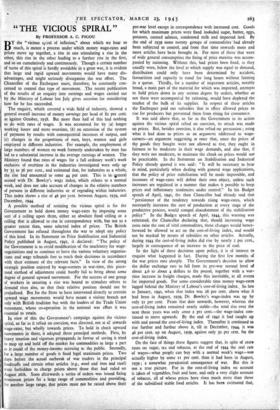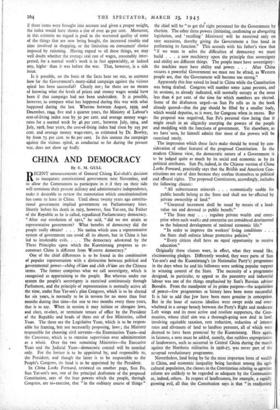" THE VICIOUS SPIRAL"
By PROFESSOR A. C. PIGOU
The enquiry, which covered a wide field of industry, showed a general overall increase of money earnings per head of 82 per cent. as against October, 1938. But more flian half of this had nothing to do with rates of wages. It was accounted for by (a) longer working hours and more overtime, (b) an extension of the system of payment by results with consequential increases of output, and (c) changes in the proportions of men, boys, women and girls employed in different industries. For example, the employment of large numbers of women on work formerly undertaken by men has led to a substantial increase in the average earnings of women. The Ministry found that rates of wages for a full ordinary week's work exclusive of overtime in the industries investigated were only up by 35 to 36 per cent., and estimated that, for industries as a whole, the rise had amounted to some 44 per cent. This is in, gieneral accord with Dr. Bowley's wage index, which relates to a normal week, and does not take account of changes in the relative numbers of persons in different industries or of regrading within industries. This index shows a rise of 46 per cent. between August, 5939, and December, 1944.
A possible • method of resisting the vicious spiral is for the Government to hold down money wage-rates by imposing some sort of a ceiling upon them, either an absolute fixed ceiling or a ceiling that is allowed to rise in correspondence with, but not to a greater extent than, some selected index of prices. The British Government has refused throughout the war to adopt any policy of this kind. In its Statement on Price Stabilisation and ,Industrial Policy published in August, 1941, it. declared: "The policy of the Government is to avoid modification of the machinery for wage- negotiations and to continue to leave the various voluntary organisa- tions and wage tribunals free to reach their decisions in accordance with their estimate of the relevant facts." In view of the strong strategic position enjoyed by wage-earners in war-time, this piece- meal method of adjustment could hardly fail to bring about some degree of general upward movement. For the success of one group of workers in securing a rise was bound to stimulate others to demand rises also, so that their relative position should not be prejudiced. But for the State to have intervened directly to restrain upward wage movements would have meant a violent breach not only with British tradition but with the leaders of the Trade Union movement, whose co-operation in the national war effort it was essential to retain.
In view of this the Government's campaign against the vicious spiral, so far as it relied on coercion, was directed, not at al: towards wage-rates, but wholly towards prices. To hold in check upward movements in these, it adopted three principal methods. First, by heavy taxation and vigorous propaganda in favour of saving it tried to mop up and hold off the market for commodities as large a part as it could of the money-income accruing to the public. Secondly, for a large number of goods it fixed legal maximum prices. Two days before the actual outbreak of war traders in the principal foodstuffs and certain 'other articles (e.g., wool and iron and steel) were forbidden to charge prices above those that had ruled on August 26th. Soon afterwards a series of orders was issued fixing maximum prices for a large range of commodities and providing, for another large range, that prices must not be raised above their pre-war level except in correspondence with increased cost. Goods for which maximum prices were fixed included sugar, butter, eggs, potatoes, canned salmon, condensed milk and imported lard. By the end of 1939 some twenty groups of commodities had already been subjected to control, and from that time onwards more and more articles have been brought in. For most of those that were of wide general consumption the fixing of price maxima was accom- panied by rationing. Without this, had prices been fixed, as they usually were, below the level at which supply was equal to demand, distribution could only have been determined by accident, favouritism and capacity to stand for long hours without fainting in a queue. Thirdly, for a number of important articles, notably bread, a main part of the material for which was imported, attempts to hold prices down in any serious degree by orders, whether or not these were accompanied by rationing, would have depleted the market of the bulk of its supplies. In respect of these articles the Exchequer paid out subsidies that in effect allowed prices to rise for producers but prevented them from rising for consumers.
It was said above that, so far as the Government in its action against the vicious spiral relied on coercion, its attack was made on prices. But, besides coercion, it also relied on persuasion ; using what it had done to prices as an argument addressed to wage- earners—an argument suggesting at once that, since the prices of the goods they bought were not allowed to rise, they ought in fairness to be moderate in their wage demands, and also that, if they were not moderate, to maintain the check on prices would not be practicable. In the Statement on Stabilisation and Industrial Policy already quoted it was said: "It will be necessary to bear in mind, particularly when dealing with general wage applications, that the policy of price stabilisation will be made impossible, and increases of wage-rates will defeat their own object, unless such increases are regulated in a manner that makes it possible to keep prices and inflationary tendencies under control." In his Budget speech of April, 1941, the then Chancellor had already said that *persistence of the tendency towards rising wage-rates, which necessarily increases the cost of production at every stage of the productive process, would compel abandonment of the stabilisation policy." In the Budget speech of April, 1944, this warning was reiterated, the Chancellor declaring that, should increasing wage costs raise the cost of vital commodities, these changes would hence- forward be allowed to act on the cost-of-living index, and would not be masked by means of subsidies on other articles. Actually, during 1944 the cost-of-living index did rise by nearly 2 per cent., largely in consequence of an increase in the price of coal.
In the light of these decisions upon policy, it is of interest to enquire what happened in fact. During the first few months of the war prices rose sharply. The Government's decision to allow the dollar exchange rate to fall from its pre-war normal level of about 4.6 to about 4 dollars to the pound, together with a war- time increase in freight charges, made this inevitable, at all events for imported goods. For some considerable time money wage-rates lagged behind the Ministry of Labour's cost-of-living index., So late as January, 1941, when that index was 28 per cent, above what it had been in August, 1939, Dr. Bowley's wage-index was up by only 21 per cent. From that date onwards, however, whereas the cost-of-living index remained nearly stable—the total rise over the next three years was only sonic 2 per cent.—the wage-index con- tinued to move upwards. By the end of 1942 it had 'caught up with and passed the cost-of-living index. Thereafter it continued to rise further and further above it, till in December, 1944, it was 46 per cent. up on August, 1939, against only 30 per cent, for the cost-of-living index.
On the face of things these figures suggest that, in spite of extra taxes on sugar, tea and tobacco, at the end of 1944 the real rate of wages—what people can buy with a normal week's wage—was actually higher by some 11 per cent. than it had been in August, 1939; a somewhat paradox cal consequence of war. But this is not a true picture. For in the cost-of-living index no account is taken of vegetables, fruit and beer, and only a very slight account of tobacco, all of whose prices have risen much more than those of the subsidised stable food articles. It has been estimated that, if these items were brought into account and given a proper weight, the index would have shown a rise of over 40 per cent. Moreover, in this estimate no regard is paid to the worsened quality of some of the things that are now being bought, the increased trouble and time involved in shopping, or the limitation on consumers' choice imposed by rationing. Having regard to all these things, we may well doubt whether the average teal rate of wages, reasonably inter- preted, for a normal week's work is in fact appreciably, or indeed any, highe- than it was before the war. That, however, is a side issue.
Is it possible, on the basis ot the facts here set out, to estimate how far the Government's many-sided campaign against the vicious spiral has been successful? Clearly not ; for there are no means of knowing what the levels of prices and money wages would have been if that campaign had not been undertaken. It is possible, however, to compare what has happened during this war with what happened during the last. Whereas between August, 1939, and December, 1944, five and a quarter years, the Ministry of Labour's cost-of-living index rose by 30 per cent, and average money wage- rates for a normal week by 46 per cent., between July, 1914, and July, 1918, four years, the cost-of-living index had risen by. Io5 per cent, and average money wage-rates, as estimated by Dr. Bowley, by from 75 per cent. to 8o per cent. In this context the campaign against the vicious spiral, as conducted so far during the present war, does not show up badly.



























 Previous page
Previous page